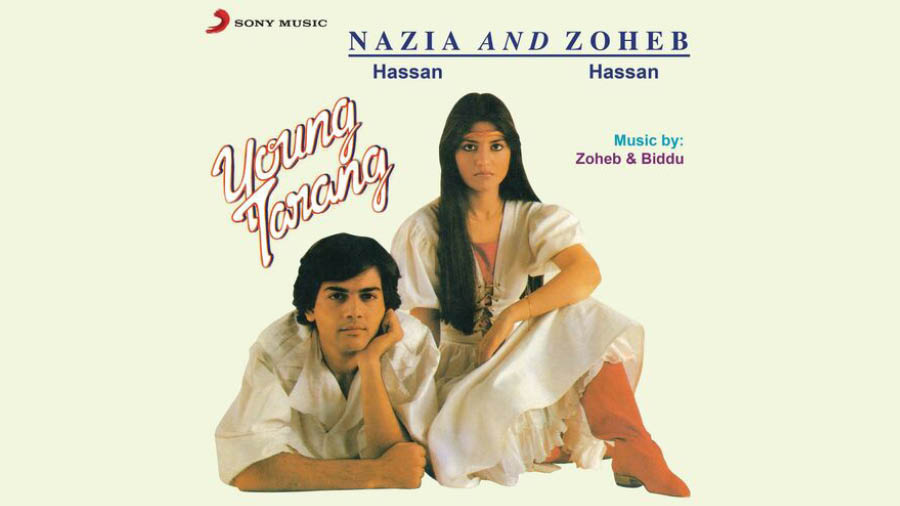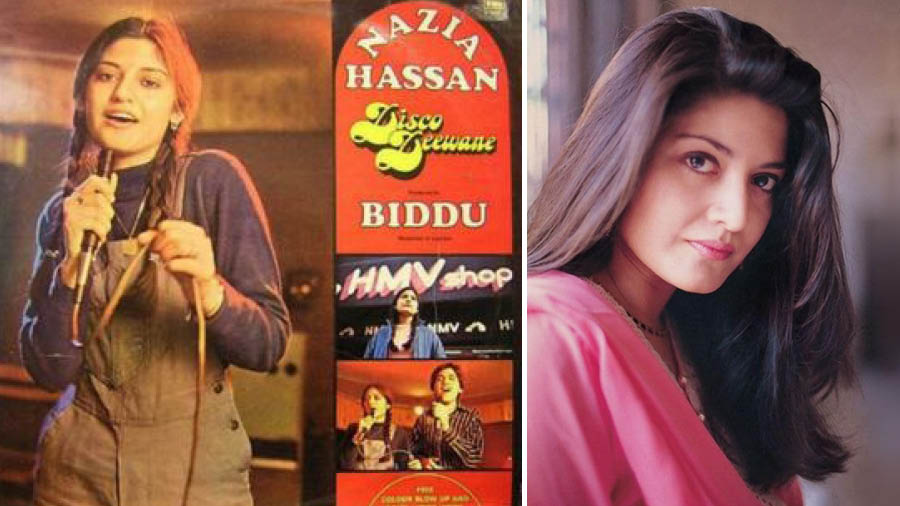A young girl in denim dungarees, hair tied into two neat, long braids took the music world by storm with Aap jaisa koi and Disco Deewane in the 1980s. Nazia Hassan was all of 14 then. If you’re a Generation X or even a millennial, or if you’re interested in the music of the times, chances are that this Pakistan-born singer-songwriter’s songs would have featured in your party playlist. She was, after all, known as the ‘Queen of South Asian Pop’!
On World Music Day, My Kolkata looks back at the life and works of Nazia Hassan, who made the people of two nations at political loggerheads unite in crooning, grooving and letting it loose with her iconic pop numbers.
First steps to stardom
The story goes that when Mumbai-based music composer duo Kalyanji-Anandji heard that director-producer-actor Feroz Khan wanted a certain Biddu and Nazia to get on board for the soundtrack of his movie Qurbani, they considered it an unsolicited risk. Especially since the rest of the numbers would be sung by big names like Mohammed Rafi, Kishore Kumar, Asha Bhonsle and Amit Kumar.
Khan was introduced to Nazia at a party in London by actress Zeenat Aman, who was part of the Qurbani cast. When he heard the young girl sing, he insisted that she record a number for his upcoming film. Composer Biddu wanted to produce a Hindi rendition of Boney M’s Rasputin, but young siblings Nazia and Zoheb had something else in mind. And that is how Aap jaisa koi was born — a number that revolutionised South Asian pop music, and pushed a teen into the spotlight of unbridled stardom.
The meteoric rise
For a young girl raised in Manchester by her grandmother, it would have been very hard to foresee the swirling success that would follow her after the release of Qurbani. Initially when Khan approached her, Nazia was understandably timid to commit because she did not want to miss school.
The final album, a resounding hit, gifted the subcontinent a star in the making. A 14-year-old’s voice on a ravishing Zeenat Aman, was the start of a decade of a different kind of sound in Bollywood. In all of its clunk, the disco and filmi-pop genre found its ground in the subcontinent. Nazia’s Aap jaisa koi served as the perfect prelude to the electro-disco wave of the 1980s — R D Burman dropped Dil lena khel hai dildar ka in 1981, and Bappi Lahiri piqued it with Disco Dancer (1982) and eventually there was the music of Namak Halal (1982) and Himmatwala (1982).
As synth and disco captured the imagination of a young (and middle-aged) South Asian cross-section, Nazia released her explosive debut album Disco Deewane in 1981 and also became the youngest recipient of the Filmfare Award for Best Playback Singer Female in the same year for Aap Jaisa Koi. Disco Deewane became the first pop album to reign the shelves in a South Asian market dominated by filmi soundtracks, the first to top charts in Brazil, and made her the first Pakistani singer to make it to the British charts. The eponymous title track has been remade and covered countless times since.
Nazia’s next three albums, Boom Boom/Star (1982), Young Tarang (1984) and Hotline (1987), shaped the initial canopy of the Indi-pop market. Young Tarang became the first album from South Asia to feature music videos, while the duo of Nazia and Zoheb became the first South Asian artistes to be signed by an international record label - EMI. These albums established Nazia as a bonafide pop star in the subcontinent and for its diaspora. The young Pakistani-British singer was now a household name, recognisably unique with a nasal tonality and rhythmic brilliance.
The year 1989 marked a prominent shift in the Pakistani musical terrain with Music ’89. It was the first pop music stage show to be televised in the country, and was hosted by Nazia and Zoheb. Music ’89 brought the likes of Vital Signs, Jupiters and Strings to the scene. These bands would shape and alter the musical sensibility of the subcontinent for years to come, even as the embers of disco eventually died down.
Nazia defined and punctuated her own reigning era with confidence. The decade — a cocktail of trends with shifting Western zeitgeist and a collective subcontinental attempt at cultural individuality — had her at the absolute top, catapulting her into stardom and eventually capping it off, with 1990s ushering in a new sound. Nazia and Zoheb’s final venture came with Camera Camera in 1992, which enjoyed modest success, but marked a certain end to the duo’s journey.

Zoheb and Nazia Hassan on the over of 'Young Tarang' YouTube
Beyond the disco ball
All through her decade-long stint, everybody wanted Nazia to be a reflection of somebody. Biddu modelled the sibling duo after The Carpenters while others saw a fusion of David Bowie, Boney M and Jackson 5. And through all of that, Nazia set herself apart with a voice that was just hers, and a charming grace that lit up the room every time she spoke.
In an interview following the success of Aap jaisa koi, teenaged Nazia with her coy smile talked about it on national television with a surprising restraint. When asked if she had aspirations to better her craft by formally training in music and dance, she replied “No, I don’t think I have the time with school going on. Maybe after college.” However, when she started singing the opening lines to the number, without any musical backing, overwhelmed as she might have been with the questions darted at her, there was a sense of conviction and ease. This conviction separated Nazia from the crowd.
She did what she loved doing, and every number of hers has the power to make one want to sing and groove. Right from the initial years of her success, Nazia’s identity was dissected and negotiated from the optics of an orthodox South Asian household. Being a pop star was far from socially respectable and certainly, the claws of familial honour sunk deep into her skin. Yet, she did all of it. Nazia wanted to have a stable professional life following her education. She majored in business administration and economics and later in law from the University of London. Well into her stardom, Nazia continued pursuing her profession and worked at the United Nations. She was a social activist and carried out numerous philanthropic drives until the very end, supporting underprivileged children.
An icon for many
Amidst all of the things in her life, Nazia sang, and so did countless women, grooving to the beats at bars and parties or in the furtive comfort of their bedrooms. In an uncompromising patriarchal and prickly South Asian set-up, a still-coy Nazia became South Asia’s Queen of Pop, opening the door for countless girls across the subcontinent with music that went beyond the traditional.
Nazia died of lung cancer in 2000, a mere 35 years old. About 10 days before her death, she divorced her husband Mirza Ishtiaq Baig. Later in an interview, her brother Zoheb talked about his sister, whom he dearly loved, “She would not share anything about her personal life with anybody. Cancer is a fatal disease, and I could see her crumbling as her chemo continued. And, her marriage was also a huge mistake”.
In many such accounts and conversations about the pop-star, she has been constrained within stories of marriage and the disease — a muted existence, where her death became a bigger definition than the work she left behind. Nazia Hassan died a young flickering star, one with a voice that was like a breath of fresh air.
Nazia’s songs were both an extension of her, as well as a veil at a point. While her body of work was defined by iconoclastic expression, everything else about her was probably concealed by the same. While much about the young star’s life remains in the shadows of her coy smile, the melodies she left behind carry a piece of her. In Nazia Hassan — a young girl who was born in Pakistan, raised in London, and built a career in the subcontinent — we find a cultural icon who gave a traditional society the soundtrack to which they could move their hips, throw their arms in the air, and sing forgetting everything else, even if just for a little while.
